
Australia’s Updated Budget Outlook
“Australia’s Budget Pain Deepens”; “Australia’s Books Awash With Red Ink”; “Australia’s Budget Blows Out”; “Australia’s Lifetime of Looming Debt.” These were just a few of the mainstream headlines following the release of Australia’s Midyear Economic and Fiscal Outlook (myefo) on December 15.
The myefo forecast dark economic skies for Australia and warned that the gloomy climate would likely remain for years to come.
The Australian government announced on Tuesday that deficit predictions in the original budget were too optimistic. Tacking on an additional $2.3 billion would make the deficit estimate more realistic at a whopping total of $37.4 billion.
This increase has added at least another year to the government’s schedule for ending the deficit. According to current estimates, the deficit will be gone around 2020-2021.
Treasurer Scott Morrison told Parliament, “We know where the destination is, and we know how we’re going to get there, and we will arrive there when expenditure is less than revenue.” But the reality is that Australia is on a dangerous road of reckless spending—it has been for some time—and the government of today is doing little to change course.
Gross domestic product growth is now forecast at 2.5 percent rather than the 2.75 percent forecast at the start of the year. This makes chasing down the deficit even harder. The economy is slowing, and that is just the beginning.
Collapsing Commodities, Vanishing Investors
Australia is a commodity-based economy. It sells what it can dig up. In recent years, however, the price of those commodities has collapsed. In 2009, Australia was selling iron ore for almost au$200 (us$137) per ton. As of the myefo’s release, that figure is down to just aus$54 (us$39) per ton. Such figures are heartbreaking for a nation that relies heavily on commodities.
The falling commodity price is pushing the Australian dollar down and causing the price of imported goods to soar.
Investment in Australia is also plummeting—nobody wants to invest in a dying commodity market.
Australia needs to transition away from commodities. The only problem is that nobody wants to invest in non-mining endeavors either. Last year, non-mining investment was expected to contract half a percent. Estimated growth for this year was hacked down from an optimistic 7.5 percent to just 4.5.
Australia is stuck. It is caught in the boom-bust cycle. Commodities boomed, the government spent money like it was going out of style. Then the boom ended. Here comes the bust. The government is racking up debt, establishing a solid yearly deficit that it has no reasonable plan to remove.
End of the Housing Boom
Growth in new homes and renovation is expected to sit at 2 percent in the next financial year, as opposed to 8.5 percent this year. It currently makes up 7.8 percent of Australia’s gdp. The government needs growth in this area.
But the myefo says that the boom is done. The end of the housing boom severely undermines the country’s ability to grow economically. The rise in housing prices enticed many Australians to use their houses like checking accounts. Since people had more money to spend, the consumer became more important in bolstering the economy. But now housing prices are leveling out—although still at prices far beyond the budget of the average Australian—and soon they may fall. What will that do to the economy?
Commodities and housing are two of the key income generators for the economy. But now the boom for both is over and the nation must face the results of years of reckless spending and short-sighted financial policy.
The Trumpet has written extensively on Australia’s economic climate over the years. A clear pattern of events led to the current scenario Australia finds itself in. Politicians talk about the road Australia is now taking, but Trumpet columnists have been writing about this journey for decades!
One such author was late Trumpet columnist Ron Fraser.
In Australia—Where to Now?, Mr. Fraser provided an in-depth, clear analysis of Australia’s financial situation. Though last published in 2008, the booklet applies more today than ever before. The events highlighted in that booklet show why Australia is where it is today! The dire straits Australia is in were foretold in that booklet!
Mr. Fraser wrote:
The root cause of Australia’s and the rest of the world’s current economic woes is simply that their monetary policies are not underpinned by the basic laws of finance and economics. … It’s easy to list the high risks that the Australian economy is currently facing: the fact that rising commodity prices and rapid monetary expansion—the driving forces behind Australia’s 10-year boom—are simply unsustainable; the fact that, because Australia’s economic future is so highly dependent upon that of China, any sharp slowdown in China poses a threat to the Australian economy; an already collapsing monetary-induced housing-price bubble; a sharp decline in household savings from 5.1 percent in 1991 to 2.7 percent in 1999 to -1.7 percent in 2004.
That was 2008. The problems have only become worse in the years since. If you haven’t read the booklet, download it free here. You will find 68 pages of clear, understandable information on where Australia has been and where it is heading. You may find it shocking and alarming, but at the same time it can be a great comfort to anyone interested in avoiding many of the dire consequences of Australia’s reckless financial policies.
